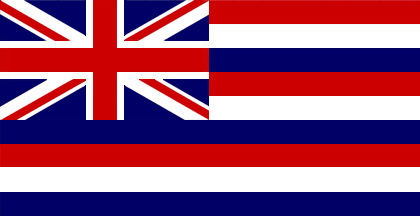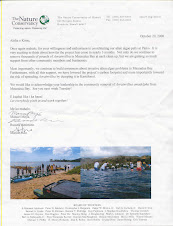This last Saturday, Oct. 13 - a group of us from Malama Maunalua led by Alyssa Miller and Christina Ryder of Ducks Unlimited ventured into Paiko Lagoon Wildlife Sanctuary for a sightseeing tour and a discussion of the flora & fauna of the area. We also were able to clean litter from the area and pull-up some of the invasive seaweed growing in the lagoon.
Alyssa had described some of the previous work that has been done in the area including removal of some of the invasive plants and trees. There removal provides space and less competition for some of the native plants to grow in the region such as the Pohuehue vine and Milo trees which are trying to keep steadfast on the beach area. Also, how Paiko Peninsula has been historically very unstable with sands constantly shifting over time.
Christina mentioned that the lagoon is very productive in regards to providing safe grounds for pua or offspring of certain fish such as oio, mullet, aholehole & kaku (barracuda). Baby mullet were seen jumping and swimming in schools throughout the area.
Not many birds were seen in the lagoon while we were there except for some Kolea (Pacific Golden Plover) & possibly a couple of 'Ulili (Wandering Tattler) off at a distance. No Ae'o (Hawaiian Stilt) or "Auku'u (Black Crowned Night Heron) were seen; although, I often do see them in the lagoon and in other areas in Maunalua such as the canals in the valleys leading to Kuapa pond. "Ulili are common to see on the beach and mud flats off Kuli'ou'ou Beach Park.
Mostly invasive seaweed was found in the lagoon such as the Gracilaria (Gorilla Ogo), Avrainvillea (Leather Mudweed) and the Acanthophora (Prickly Seaweed). Where the mudweed was growing it was quite soft & muddy. Your feet sink into the sediment making it difficult to walk at times. Although, mostly all of the seaweed I observed was invasive - I did see a small pocket of Limu Palahalaha. Another green seaweed was growing in small areas in which I cannot remember the name other than it has "tax" in part of its scientific name. The leaves look like small palm fronds. I don't know if this particular seaweed is an invasive or native seaweed. It was growing right at the inlet into the lagoon. There is some Limu 'Ele'ele growing on rocks outside the lagoon; however, I didn't see any inside the lagoon.
The Avrainvillea seaweed which is growing thickly on the flats outside the lagoon I had heard is not liked by fish. From my observations in this area, this seems to be true. I never see much fish in the area where it is growing other than a periodic barracuda.
Paiko Lagoon is a beautiful place and very unique to this area now. I view it as sort of a last vestige of what was once common in this area before Kuapa pond was dredged and developed by Henry Kaiser.
Sunday, October 14, 2007
Kupapa Fishpond - Ahupua'a 'o Niu
Where Niu Iki Circle is now adjacent to Kalanianaole Highway and opposite (makai) of Niu Shopping Center was once an ancient Hawaiian fish pond called Kupapa.
The pond was filled in and used for agricultural purposes before house were built in that location. The wall of the pond was originally 3 feet high and 8 feet in width forming a semicircle approx. 2000 feet long. The pond area was several acres in size - McAllister (Archeology of Oahu) & Sterling & Summers p. 273 (Sites of Oahu ).
Does anyone have any information or knowledge regarding the old Kupapa pond area prior to houses being built on it in approx. the 1960's.
The pond was filled in and used for agricultural purposes before house were built in that location. The wall of the pond was originally 3 feet high and 8 feet in width forming a semicircle approx. 2000 feet long. The pond area was several acres in size - McAllister (Archeology of Oahu) & Sterling & Summers p. 273 (Sites of Oahu ).
Does anyone have any information or knowledge regarding the old Kupapa pond area prior to houses being built on it in approx. the 1960's.
Ahupua'a 'o Maunalua
On Saturday, Oct. 6 - It was good fun taking a leisurely walk up the private road atop 642 foot high Koko Head originally called "Mo'okua 'o Kaneapua" and "Kuamo'okane" with other members of Malama Maunalua. The group was led by Alissa Miller and Anne Rosa.
Both Alissa and Anne gave interesting insights about the surroundings of the area as they focused on Maunalua and Hanauma Bays.
Anne pointed out interesting cultural & historical aspects of the area such as the wind of Hanauma which is called 'Ihi'ihilauakea. Also, a crater of the same name is located in Koko Head to the west of Hanauma where a very rare native fern grows. She mentioned how Hanauma was used as a launching point for Hawaiian sailing canoes heading out to sea. The bay providing a safe, sheltered habitat and an abundance of seafood while waiting for ideal conditions to launch.
Alissa informed us about Maunalua Bay and what some of Malama Maunalua's current & upcoming projects are for Maunalua Bay. Also, the importance of continued monitoring of Maunalua Bay by Makai Watch members. The view of both bays was quite impressive from our vantage points.
Mahi La Pierre had told us the mo'olelo of Kuamo'okane at a previous Malama Maunalua Makai Watch meeting. In brief, Kuamo'okane is the back of Kaneapua (Kuamo'okane). A version of the story can be told on a future posting.
Both Alissa and Anne gave interesting insights about the surroundings of the area as they focused on Maunalua and Hanauma Bays.
Anne pointed out interesting cultural & historical aspects of the area such as the wind of Hanauma which is called 'Ihi'ihilauakea. Also, a crater of the same name is located in Koko Head to the west of Hanauma where a very rare native fern grows. She mentioned how Hanauma was used as a launching point for Hawaiian sailing canoes heading out to sea. The bay providing a safe, sheltered habitat and an abundance of seafood while waiting for ideal conditions to launch.
Alissa informed us about Maunalua Bay and what some of Malama Maunalua's current & upcoming projects are for Maunalua Bay. Also, the importance of continued monitoring of Maunalua Bay by Makai Watch members. The view of both bays was quite impressive from our vantage points.
Mahi La Pierre had told us the mo'olelo of Kuamo'okane at a previous Malama Maunalua Makai Watch meeting. In brief, Kuamo'okane is the back of Kaneapua (Kuamo'okane). A version of the story can be told on a future posting.
Saturday, October 6, 2007
Ahupua'a 'o Niu - The Old Niu Valley Pier
In Maunalua Bay, in the ahupua'a of Niu in the Kona district of Oahu - up until sometime (approx.) in the late 1970's or early 1980's there was an old pier that extended out in front of Niu Valley (just Diamond Head side of Niu Peninsula or Niu Iki Circle (once an ancient fish pond named Kupapa). The old wood plank pier extended out approx. a 1/4 mile over the reef flat or about 2/3rds of the way to the breakers from the beach.
There was a platform on the very end of the pier (maybe about 10 ft x 10 ft) with a metal ladder. The pier was used when I was a kid for playing, fishing, flying kites off the end of and for a shorter paddle out surfing. We had some great games of king of the pier there. King of the pier consisted of pushing others kids, who wanted to play, off the end of the pier into the water and the last one standing on the pier was the winner (I was usually one of the first to get thrown off and don't ever remember winning the lucky title of king of the pier).
Does anyone know when the pier was originally built and for what purpose? Did it have something to do with the cattle & dairy ranches that were in this area before residential development? The pier was in disrepair when we played and walked on it as kids. Some of the planks were very springy.
Also, in Maunalua Bay - old rusting metal piles are in the water to this day off Paiko peninsula in front of the neighboring ahupua'a of Kuliou'ou. What structure or function were these piles originally a part of? There is no channel adjacent to the piles; however, there is a channel running parallel to the shore in front of Kuliou'ou Beach Park (appor. 50 yards off-shore). The piles are on the reef flat directly outside Kuliou'ou stream outlet adjacent to Kuliou'ou Beach Park.
There was a platform on the very end of the pier (maybe about 10 ft x 10 ft) with a metal ladder. The pier was used when I was a kid for playing, fishing, flying kites off the end of and for a shorter paddle out surfing. We had some great games of king of the pier there. King of the pier consisted of pushing others kids, who wanted to play, off the end of the pier into the water and the last one standing on the pier was the winner (I was usually one of the first to get thrown off and don't ever remember winning the lucky title of king of the pier).
Does anyone know when the pier was originally built and for what purpose? Did it have something to do with the cattle & dairy ranches that were in this area before residential development? The pier was in disrepair when we played and walked on it as kids. Some of the planks were very springy.
Also, in Maunalua Bay - old rusting metal piles are in the water to this day off Paiko peninsula in front of the neighboring ahupua'a of Kuliou'ou. What structure or function were these piles originally a part of? There is no channel adjacent to the piles; however, there is a channel running parallel to the shore in front of Kuliou'ou Beach Park (appor. 50 yards off-shore). The piles are on the reef flat directly outside Kuliou'ou stream outlet adjacent to Kuliou'ou Beach Park.
Subscribe to:
Posts (Atom)








